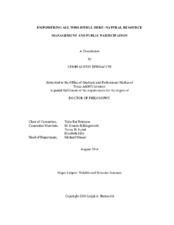| dc.contributor.advisor | Peterson, Tarla Rai | |
| dc.creator | Bernacchi, Leigh Alexis | |
| dc.date.accessioned | 2015-02-05T17:24:06Z | |
| dc.date.available | 2016-08-01T05:30:00Z | |
| dc.date.created | 2014-08 | |
| dc.date.issued | 2014-08-01 | |
| dc.date.submitted | August 2014 | |
| dc.identifier.uri | https://hdl.handle.net/1969.1/153320 | |
| dc.description.abstract | I studied the potential for community-based planning in the winter habitat of the federally-endangered whooping crane (Grus americana) to better understand the relationships, barriers and opportunities to conservation and public participation.
Rooted in the literature of public participation in natural resource management, I describe my project within this larger discourse. I seek to address the issue of local public resource management and the ways in which it is or is not represented in public processes. I submit constructive ameliorations for improved democratic engagement, resource and wildlife conservation. My methods are qualitative: 35 local and regional individuals interested in crane conservation were interviewed, transcribed, and coded in NVivo Qualitative Analysis software from QSR International to conduct a content analysis. I employed theoretical and pragmatic constructions to provide constraints and perspectives on the same dataset.
I apply a ritual communication perspective to the communication among birdwatchers and with birds. Though a wide-ranging topic, I describe the key aspects of birding, and how competition and cooperation are the two sides of birding’s social relations. I propose that wildlife managers could pay attention to these relationships to better represent interests in birds in management.
I examine how wildlife managers are tasked with engaging the public for natural resource management and planning, and I propose that including a responsive public can improve the plan and conservation. I found that the public was amenable to working with wildlife managers due to whooping the crane’s iconic nature and economic value, and the public was responsive to agency intervention when they were dependent on their knowledge and standing for navigating the dynamic complexity of managing the species and ecosystem. By recognizing a responsive public, wildlife managers can expand public participation to include more public perspectives.
From a public understanding of science perspective, I explore the dominant scientific narratives associated with whooping crane conservation. I examine these narratives for their ability to empower and to constrain public participation in various management schemes. I argue that production of a reductive scientific narrative reproduces an equally reductive public discourse that limits possibilities for public participation. | en |
| dc.format.mimetype | application/pdf | |
| dc.language.iso | en | |
| dc.subject | conservation | en |
| dc.subject | expertise | en |
| dc.subject | public understanding of science | en |
| dc.subject | endangered species | en |
| dc.subject | public participation | en |
| dc.subject | democracy | en |
| dc.title | Empowering All Who Dwell Here: Natural Resource Management and Public Participation | en |
| dc.type | Thesis | en |
| thesis.degree.department | Wildlife and Fisheries Sciences | en |
| thesis.degree.discipline | Wildlife and Fisheries Sciences | en |
| thesis.degree.grantor | Texas A & M University | en |
| thesis.degree.name | Doctor of Philosophy | en |
| thesis.degree.level | Doctoral | en |
| dc.contributor.committeeMember | Killingsworth, M. Jimmie | |
| dc.contributor.committeeMember | Jamal, Tazim B. | |
| dc.contributor.committeeMember | Ellis, Elisabeth | |
| dc.type.material | text | en |
| dc.date.updated | 2015-02-05T17:24:06Z | |
| local.embargo.terms | 2016-08-01 | |
| local.etdauthor.orcid | 0000-0002-1447-0447 | |


